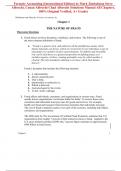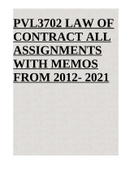Forensic Accounting (International Edition) 4e Mark Zimbelman Steve
Albrecht, Conan Albrecht Chad Albrecht (Solutions Manual All Chapters,
100% Original Verified, A+ Grade)
Zimbelman and Albrecht: Forensic Accounting, 4e
Chapter 1
THE NATURE OF FRAUD
Discussion Questions
1. Fraud always involves deception, confidence, and trickery. The following is one of
the most common definitions of fraud:
a. “Fraud is a generic term, and embraces all the multifarious means which
human ingenuity can devise, which are resorted to by one individual, to get an
advantage over another by false representations. No definite and invariable
rule can be laid down as a general proposition in defining fraud, as it
includes surprise, trickery, cunning and unfair ways by which another is
cheated. The only boundaries defining it are those which limit human
knavery.”
Fraud is deception that includes the following elements:
1. A representation
2. About a material point
3. That is false,
4. Intentionally or recklessly so,
5. Which is believed
6. And acted upon by the victim
7. To the victim’s damage.
2. Fraud affects individuals, consumers, and organizations in various ways. Fraud
usually lowers organizations’ net income dollar for dollar. To recover these costs,
consumers and individuals must pay more for goods and services. For example,
health care fraud and insurance fraud increase premiums that individuals must pay.
The cost of fraud eventually reaches every part of the economy, including individuals,
consumers, and organizations.
The 2008 study by The Association of Certified Fraud Examiners estimates that U.S.
organizations lose roughly 7 percent of their annual revenues to fraud. Applied to the
U.S. gross domestic product (GDP), this 7 percent figure translates to approximately
$994 billion in fraud losses.
Chapter 1 1
© 2012 Cengage Learning. All Rights Reserved. This edition is intended for use outside of the U.S. only, with content that may be different
from the U.S. Edition. May not be scanned, copied, duplicated, or posted to a publicly accessible website, in whole or in part.
,Zimbelman and Albrecht: Forensic Accounting, 4e
3.
a. Employee Embezzlement: In this type of fraud, employees deceive their
employers by taking company assets. Embezzlement can be either direct or
indirect.
b. Management Fraud: Distinguished from other types of fraud both by the
nature of the perpetrators and by the method of deception. In its most common
form, management fraud is deception perpetrated by top management’s
manipulation of financial statements. The victims of management fraud are
typically stockholders, lenders, and others who rely on financial statement
information.
c. Investment Scams or Consumer Scams: A type of fraud that is perpetrated
when fraudulent and usually worthless investments are sold to unsuspecting
investors.
d. Vendor Fraud: Perpetrated by vendors; comes in two main varieties: fraud
perpetrated by vendors acting alone, and fraud perpetrated through collusion
between buyers and vendors. Vendor fraud usually results in an overcharge
for purchased goods, the shipment of inferior goods, or the nonshipment of
goods even though payment was made.
e. Customer Fraud: Usually involves customers not paying for goods
purchased, getting something for nothing, or deceiving organizations into
giving them something they should not have.
4.
a. Criminal law is the branch of law that deals with offenses of a public nature.
Criminal laws generally deal with offenses against society as a whole.
Violators of criminal laws are prosecuted either federally or by a state for
violating a statute that prohibits some type of activity.
b. Civil law is the body of law that provides remedies for violations of private
rights. Civil law deals with rights and duties between individuals. The purpose
of a civil lawsuit is to compensate for harm done to an individual. Unlike
criminal cases, where juries consist of 12 jurors, juries in civil cases may have
as few as six jurors, and the verdict of the jury need not be unanimous.
Additionally, judges often hear civil cases instead of juries. In civil lawsuits,
plaintiffs must only prove their case by the “preponderance of the evidence.”
In other words, there need be only slightly more evidence supporting the
plaintiff than supporting the defendant.
Chapter 1 2
© 2012 Cengage Learning. All Rights Reserved. This edition is intended for use outside of the U.S. only, with content that may be different
from the U.S. Edition. May not be scanned, copied, duplicated, or posted to a publicly accessible website, in whole or in part.
,Zimbelman and Albrecht: Forensic Accounting, 4e
5.
a. Civil
b. Criminal
c. Civil
d. Criminal
e. Criminal
f. Civil
g. Criminal
h. Civil
6. Charles Ponzi was successful for several reasons. First, Charles Ponzi built
confidence in his scheme by giving early investors a return on their initial
investments. Second, Charles Ponzi presented his coupon scheme in a way that was
easy for investors to understand. Although the coupon scheme never made any real
profits, investors believed that it had. Third, Ponzi was extremely talented at
manipulating victims’ emotions. Ponzi was able to capitalize on individuals’ greed.
When people began to see their friends and family members receive dividends from
investments, they too wanted in on the investment scam.
7. As the number of frauds and the amounts of fraud losses increase, so do the
opportunities for successful careers in fraud prevention and detection. In Chapter 1,
we have listed five areas in fraud fighting that will be rewarding and have high
demand in the future. They include the following:
a. Government: This includes FBI, postal inspectors, Criminal Investigation
Division of the IRS, U.S. Marshals, inspectors general of various
governmental agencies, state investigators, and law enforcement officials.
b. CPA Firms, Forensic Accounting Firms, Litigation Support Firms, and
Law Firms: These individuals will conduct investigations, support firms in
litigation, do bankruptcy-related fraud work, serve as expert witnesses, consult
in fraud prevention and detection, and provide other fee-based work.
c. Corporations: Individuals who work for corporations will prevent, detect,
and investigate fraud within a company. This category includes internal
auditors, corporate security officers, and in-house legal counsels.
d. Lawyers: Lawyers will defend or prosecute organizations in civil and
criminal cases.
e. Consulting: University Professors, Hospital Management, Technology
Corporations, etc.: People who work in these areas will consult, serve as
expert witnesses, extract evidence from computers and servers, investigate
public records, and serve on grand or trial juries.
Chapter 1 3
© 2012 Cengage Learning. All Rights Reserved. This edition is intended for use outside of the U.S. only, with content that may be different
from the U.S. Edition. May not be scanned, copied, duplicated, or posted to a publicly accessible website, in whole or in part.
, Zimbelman and Albrecht: Forensic Accounting, 4e
8. When employee fraud takes place, employees deceive their employers by taking
company assets. Management fraud is distinguished from employee fraud and other
types of fraud in that top management typically commits it to deceive financial
statement users. Employee fraud is usually committed against an organization,
whereas management fraud is perpetrated on behalf of an organization.
9. As the numbers of frauds committed and the total dollar amounts lost from fraud
increase, the demand for careers to prevent and detect such fraud will increase. In
fact, a few years ago, Fortune magazine identified forensic accounting or fraud
examination as one of the fastest growing and most financially rewarding careers.
The American Institute of Certified Public Accountants recently touted forensic
accounting/fraud examination as one of the six fastest growing and most profitable
opportunities for accountants.
10. There are a number of reasons why accurate fraud statistics are hard to find. First, it is
impossible to know what percentage of fraud perpetrators are actually caught. Are
there perfect frauds that are never discovered, or are all frauds eventually exposed?
Second, many frauds that are discovered are handled quietly within the victim
organizations and are never made public. In many cases, companies merely hide
frauds due to public relations concerns and terminate or transfer perpetrators quietly.
11. Losses incurred from fraud reduce a firm’s income on a dollar-for-dollar basis,
reducing net income by $1 for every dollar that is lost to fraud. To make up for the
damage fraud does to net income, a company has to have much more revenue come
in. For example, if a company has a profit margin of 10%, to make up for a
$1,000,000 fraud, the company would have to have additional revenue of
$10,000,000.
12. Since confidence is typically needed for fraud to occur, people who are not trusted
will not be in a position to commit a fraud.
13. While answers may vary, the following is one possible answer: The case of Charles
Ponzi involved deception, greed on behalf of the investors and the perpetrator and
confidence in the perpetrator. These are traits that are common in many different
cases of fraud.
14. The Association of Certified Fraud Examiners (ACFE) provides the opportunity for
individuals to become a Certified Fraud Examiner or “CFE”. CFEs are considered to
be leaders in the antifraud community and have recognition as such throughout the
world. They represent the highest standards held by the ACFE and possess expertise
in all aspects of the antifraud profession. The CFE designation is acknowledged
globally and preferred by many employers. The ACFE states that becoming a CFE
immediately sets an individual apart from others and launches him or her to the top of
the profession.
Chapter 1 4
© 2012 Cengage Learning. All Rights Reserved. This edition is intended for use outside of the U.S. only, with content that may be different
from the U.S. Edition. May not be scanned, copied, duplicated, or posted to a publicly accessible website, in whole or in part.





